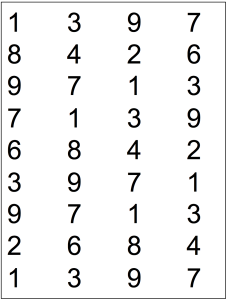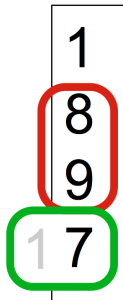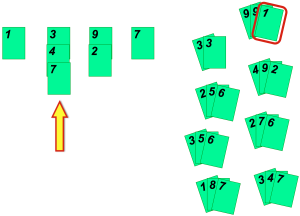It’s the tail end of summer! Get in the last family vacation, the last trips to the pool, and the last lazy days of summer. This week’s game is Short Chain Solitaire from Math Card Games by Joan A. Cotter. This game is from the addition chapter, game A47. Although this is a solitaire game, combine players to “beat the cards”. Using some strategy, players can win about three-fourths of the time. Older children and younger children who knows their addition facts will enjoy this game while they keep their addition facts strong and sharp while having hours of fun.
 The object of the game is to build the following four columns shown on the right. If an error is made, the game cannot be won.
The object of the game is to build the following four columns shown on the right. If an error is made, the game cannot be won.
First, we need to look at the “chain” of numbers. A chain is composed of links. Each link, after the first two, is formed by adding the previous two numbers while disregarding any 1 in the ten’s place.
Well, that’s a mouthful! Let me make it easier. Look at the first column. See the 1, 8, and 9? What’s 1 + 8? Nine!
Now let’s move down a link.  We now have 8, 9, and 7. What’s 8 + 9? Seventeen. Drop the one in 17 and there’s the 7. See the figure to the right.
We now have 8, 9, and 7. What’s 8 + 9? Seventeen. Drop the one in 17 and there’s the 7. See the figure to the right.
Move down another link. We now have 9 and 7. 9 + 7 = 16, so we write 6. Moving down again it’s 7 + 6 = 13, so we write 3.
Look at the first column’s last numbers, 2 and 1. They add up to 3, right? Check out the top number of the second row! Each column will link into the next, even from the last column back to the first column. Also notice that the last number in each column is the same as the first number in that column. Cool, right? This also tells the players that they are at the end of that column.
So, to play this game, you will need the following cards:
Card Number: 1 2 3 4 5 6 7 8 9
How many: 6 3 6 3 0 3 6 3 6
Shuffle the 36 cards and lay them out in fans with four cards each. Beginners may prefer to use three cards in each fan. Give the players a list of the beginning numbers so they can start the links:
1 3 9 7
8 4 2 6
The rules for play are this:
1. Only the top card of each fan is available for play. Obviously, the players can see what’s underneath to plan future moves.
2. The columns need not be kept even. The players can play on any of the four columns, depending on what cards are available.
3. The cards within each column must be built in order. This is where the addition facts come in!
4. The last card of any column may be transferred to another column. This allows for increased strategy and fun.
5. One reshuffle is allowed. When no more cards can be played, the remaining cards may be picked up, shuffled, and laid out in fans of three cards each. Of course, your family can modify this rule!
Here’s a game in progress.  See how we have started the columns? Right now, we’re working on the second column. 4 + 7 = 11, so we have a 1 located and ready to add. We could also use that 1 for the third column. You can quickly see how strategy comes into play….
See how we have started the columns? Right now, we’re working on the second column. 4 + 7 = 11, so we have a 1 located and ready to add. We could also use that 1 for the third column. You can quickly see how strategy comes into play….
If you’d like to watch a video discussing how the chains work, we’ve got that right here for you.
Just so you know, there are eight more versions of the Chain Solitaire games found in the Math Card Games book, including subtraction versions. Have a great week, play some math card games, and we’ll see you next week with a new game! Don’t forget to leave a comment and tell us how’s it going…..

Great idea, having math games introduced for summer play!
Just wanted to comment that there is a mistake in your picture of the game in process. The 1 and the 7 columns should have the 2nd cards (8 and 6 respectively) because you need to start with the 2 rows of cards so you have the starting numbers to add.
Keep the games coming!
Ironically, that’s what I thought at first too! However, if you want to lay those cards out, you’d have to fish those specific eight cards out of the deck before the game even begins. Leaving them in the deck then creating the fans increases the strategic thinking and challenge. Personally, I just write the two rows of “starting” numbers on a piece of paper, then let the fun begin from there.
Thanks for your input, Heather! Look for the summer featured game next week…..
LOVE this idea!